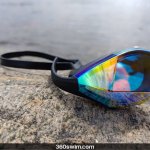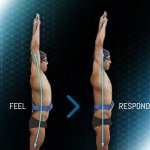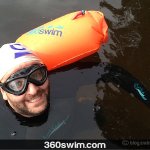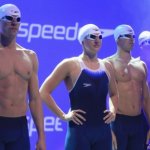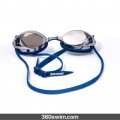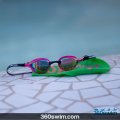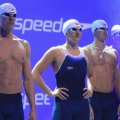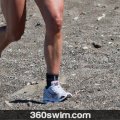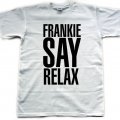A SWIMMER'S GUIDE TO LASER EYE SURGERY (TIRED OF PRESCRIPTION GOGGLES?)
Squinting to see the pace clock. Swimming in a zig-zag in open water because you can't see the buoy. Constantly taking off your goggles to see the workout on the board.
If you wear glasses or contacts on land, you know these frustrations all too well.
For swimmers, poor vision isn't just an annoyance; it can seriously hinder your enjoyment and performance.
There is, however, a modern solution: laser eye surgery. In this post, guest author and keen swimmer Jason Sanderson explains how this technology can offer a permanent fix.
Dive Into: A Swimmer's Guide to Laser Eye Surgery
- The Problem: The Hassle of Swimming with Poor Vision
- The Solution: An Overview of Laser Eye Surgery
- The Cost: A Long-Term Investment
- The Procedure, Recovery, and Risks
- A Pro's Perspective: How it Saved a Career
- Frequently Asked Questions
The Problem: The Hassle of Swimming with Poor Vision
Having poor vision can often spoil your enjoyment of swimming. It's very difficult to be ahead of the game if you can't see the pace clock, the turning buoy, or your competitors.
- Contact Lenses: Swimming in contacts is not recommended. Chlorine and bacteria can get trapped under the lens, leading to a high risk of eye infections. Plus, it's incredibly easy to lose one in the water.
- Prescription Goggles: While a good option, prescription swimming goggles can be uncomfortable for long periods and a race-ending disaster if they are lost or broken.
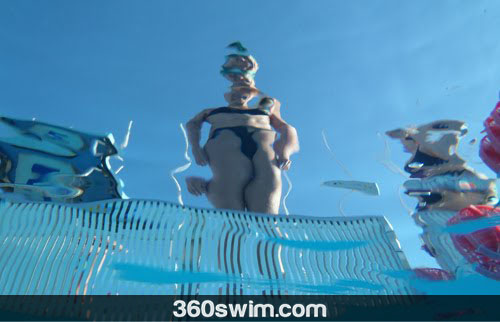
The Solution: An Overview of Laser Eye Surgery
One of the biggest advantages of laser eye surgery is the freedom it can give to dedicated swimmers.
The procedure is a modern and accessible solution that corrects your vision, usually permanently. For many, it means a lifetime of seeing clearly both in and out of the water, without the need for any corrective eyewear.
The Cost: A Long-Term Investment
In the long term, constantly replacing prescription goggles can be more expensive than laser eye surgery.
A 30-year-old swimmer who replaces their mid-range prescription goggles every two years could spend thousands over their lifetime. While the cost of laser eye surgery has increased since this article was first written, now ranging from around $2,000 to $4,000+ per eye in 2025, it is a one-time investment that benefits every aspect of your life.

The Procedure, Recovery, and Risks
Modern laser eye surgery is usually effective, painless, and over in just a few minutes. There are two main types relevant to swimmers:
- LASIK: This is the most common procedure. It involves creating a thin flap on the cornea to reshape the tissue underneath. Vision returns very quickly, often within a day.
- LASEK (or PRK): This procedure works on the surface of the cornea without creating a flap. The initial recovery is longer and more uncomfortable, but it avoids any long-term risks associated with the corneal flap.
For swimmers and other athletes, it's worth discussing LASEK/PRK with your doctor. Because it doesn't create a flap, some surgeons recommend it to eliminate the very small risk of the flap being dislodged by an accidental impact in a crowded lane or race.
Regardless of the type, the recovery time is relatively quick, and you can typically return to swimming in just four weeks.
Millions of people have had the surgery, and the risks are very low. While minor complications like temporary dry eyes can occur, serious or long-lasting damage to vision is extremely rare.
Disclaimer: This article is for informational purposes only. You must consult a qualified ophthalmologist to determine which procedure, if any, is right for you.
A Pro's Perspective: How it Saved a Career
This definitely sounds like a career saver for a competitive swimmer.
My childhood friend, Rostislav Vitek, a top-level open water swimmer, praises the surgery. When he first started, he too wore glasses and struggled to see. After he made the decision to undergo laser eye surgery, he never looked back. His career took off, and he went on to represent his country in the Olympics.
So, if poor eyesight is causing you problems, why not find out more about what modern science can do for you?
This guide was written in collaboration with Jason Sanderson, an extremely keen swimmer and writer.
Frequently Asked Questions
Is it safe to swim with contact lenses?
It is not recommended. The chlorine in pools and bacteria in open water can get trapped under soft lenses, leading to a high risk of eye infections. There is also a high chance of losing a lens in the water.
What are the downsides of prescription swimming goggles?
While they work well, prescription goggles can be uncomfortable for long swims, expensive to replace (especially if your prescription changes), and a race-ending problem if they are lost or broken.
Is laser eye surgery a good long-term solution for swimmers?
For many, yes. It can be a career-saver for competitive swimmers and a huge quality-of-life improvement for recreational swimmers, eliminating the need for any corrective eyewear in the water. Over a lifetime, it can even be more cost-effective than repeatedly buying prescription goggles.
How long is the recovery time before I can swim again after laser eye surgery?
The recovery time is relatively quick. Most surgeons recommend staying out of the pool for about four weeks to ensure your eyes have fully healed and to avoid any risk of infection.
Is laser eye surgery safe?
Modern laser eye surgery (like LASIK or LASEK) is considered very safe with low risks. While minor complications like dry eyes can occur, serious or long-lasting damage to vision is extremely rare. Always consult a qualified ophthalmologist to see if you are a good candidate.
 LNURL1DP68GURN8GHJ7URP0YHRXD3SWDMKJMFWVDHK6TMVDE6HYMRS9A4HSCNCWFXSH3NN0H
LNURL1DP68GURN8GHJ7URP0YHRXD3SWDMKJMFWVDHK6TMVDE6HYMRS9A4HSCNCWFXSH3NN0H
